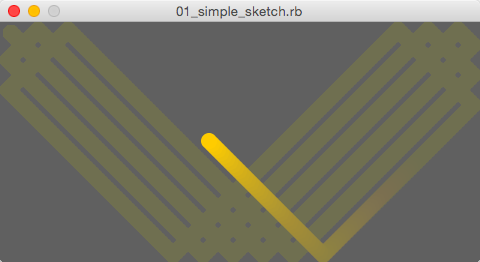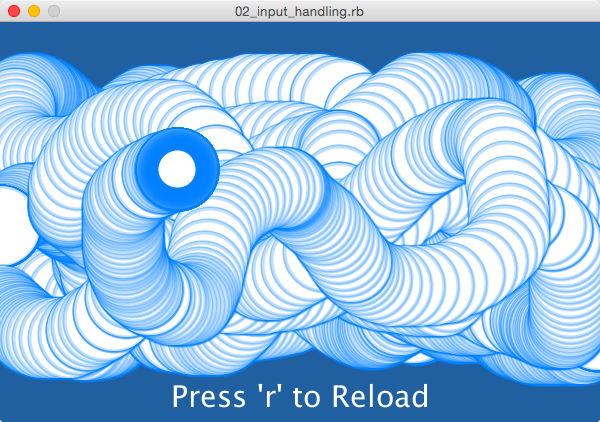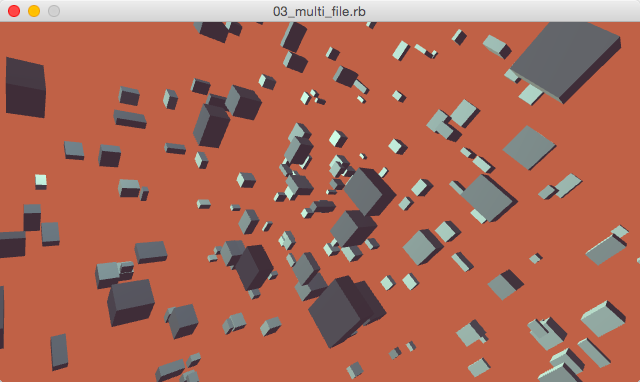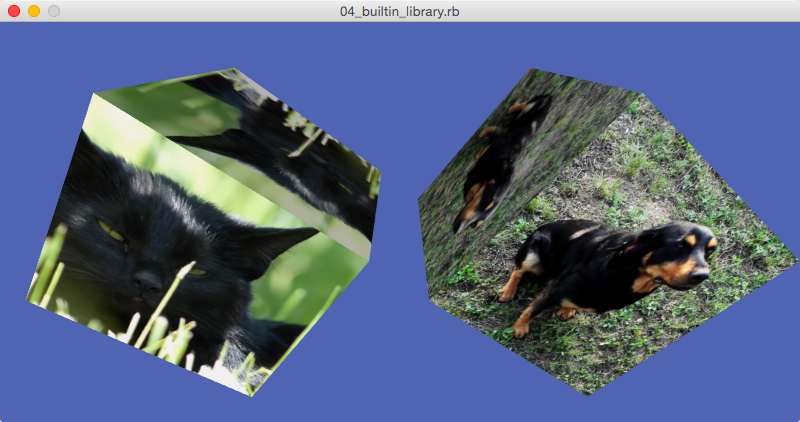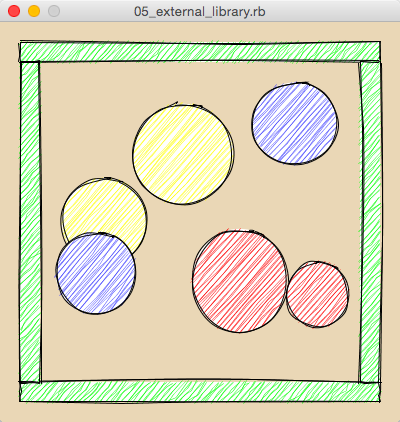Processing.rb
Processing.rb enables you to write various Processing sketches in Ruby easily.
Features
Compared to similar tools, Processing.rb has the following features:
- Requires no configuration file and available with just adding a module to your Ruby code
- Reloads the sketch file and loaded modules automatically when the related files are updated
- Available to use extension libraries for Processing with just adding a few line code in the same way as Processing
- Provides useful functions for live coding, such as setting the window position and showing it in the topmost
Screenshots
The following are screenshots of the examples of Processing.rb. Click each image to view the source code.
How to Install
Preparations
In order to use Processing.rb, installation of Ruby and Java is required. Each tool can be obtained from the following sites:
Installing Processing.rb
Processing.rb can be installed with the gem command of Ruby.
gem install processing.rb
If a permission error occured while installation, please add the sudo command at the head of the above command.
In a proxy environment such as in an office, please add a proxy configuration as -p option at the end of the above command, such as -p http://proxy.hostname:port.
After installation, the examples of Processing.rb can be copied to the ~/processingrb_examples directory with the following command:
setup_processingrb_examples
How to Use
Creating a sketch
In Processing.rb, a sketch is created as a derived class from the Processing::SketchBase class. And it starts rendering by calling the Processing.#start function.
require 'processing'
class Sketch < Processing::SketchBase
def setup
# implement your own setup code
end
def draw
# implement your own draw code
end
end
Processing.start(Sketch.new)
In the Processing::SketchBase class, the constants of Processing in Java such as HALF_PI can be used as the same name. Regarding the functions and variables of Processing, their names are snake-cased. For example, no_stroke in the case of noStroke in Java.
Please check the actual code in the examples.
A sketch file can be run in the same way as a usual Ruby code.
ruby [sketchfile]
Only for the first time, JRuby and Processing will be downloaded to the ~/.processing.rb directory. The proxy setting to download will be asked at that moment. Please input it or just press Enter without any input if not necessary, and wait for a while.
While the sketch file is running, it will be reloaded automatically when the .rb files in the same directory are updated.
Handling input data
The information of the keyboard and mouse can be obtained in the same way as Processing in Java.
But please note that the keyPressed and mousePressed methods in Java are renamed to key_pressed? and mouse_pressed? to avoid duplication of the method names.
def draw
if mouse_pressed?
ellipse(mouse_x, mouse_y, 10, 10)
end
end
def key_pressed
Processing.reload if key == 'r'
end
This example draws circles when the mouse button is pressed, and restarts the sketch when the R key is pressed.
Using an extension library
An extension library for Processing can be used in Processing.rb in the same way as Processing in Java.
For example, in the case of the sketch uses the video extension library like this:
import processing.video.*;
Movie movie;
void setup() {
movie = new Movie(this, "sample.mov");
movie.loop();
}
In Processing.rb, it goes as follow:
Processing.load_library 'video'
Processing.import_package 'processing.video', 'Video'
class Sketch < Processing::SketchBase
def setup
@movie = Video::Movie.new(self, Processing.sketch_path('sample.mov'))
@movie.loop
end
When a file path for a Java library is specified in Processing.rb, it should be an absolute path. So this example uses the Processing.#sketch_path function to convert the relative path from the sketch directory to the absolute path.
In the case of using an extension library not bundled in Processing, please make the libraries directory in the same directory as the sketch file and place the library in it.
Live coding
With passing optional parameters to the Processing.#start function, the both an editor screen and a sketch window can get more visible. It helps with editing code in parallel with checking its rendering result.
Processing.start(Sketch.new, topmost: true, pos: [300, 300])
The options of the Processing.#start function are as follows:
| Option | Description |
|---|---|
| topmost: | When its value is true, the sketch window always appears in the topmost. |
| pos: | The sketch window appears in the position [x, y]. |
API Reference
Processing module
The Processing module provides the classes and methods for a Processing sketch.
| Constant | Description |
|---|---|
| SKETCH_FILE | The path of the sketch file in the absolute path |
| SKETCH_NAME | The name of the sketch file without the directory |
| SKETCH_DIR | The directory of the sketch file in the absolute path |
| Class | Description |
|---|---|
| SketchBase | The base class of a Processing sketch |
| Method | Description |
|---|---|
| load_library(name) | Loads the specified Processing library |
| load_jars(dir) | Loads all of the .jar files in the specified directory |
| import_package(package, module_name) | Imports all of the classes in the specified Java package to the specified module |
| sketch_path(path) | Converts the relative path from the sketch directory to the absolute path |
| start(sketch, topmost: false, pos: nil) | Starts to render the specified sketch instance |
| reload | Reloads the sketch file manually |
License
Processing.rb is under MIT license. Feel free to use it.
Have fun!
